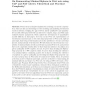Free Online Productivity Tools
i2Speak
i2Symbol
i2OCR
iTex2Img
iWeb2Print
iWeb2Shot
i2Type
iPdf2Split
iPdf2Merge
i2Bopomofo
i2Arabic
i2Style
i2Image
i2PDF
iLatex2Rtf
Sci2ools
107
click to vote
CONSTRAINTS
2016
2016
On enumerating minimal siphons in Petri nets using CLP and SAT solvers: theoretical and practical complexity
Abstract Petri nets are a simple formalism for modeling concurrent computation. They are also an interesting tool for modeling and analysing biochemical reaction systems, bridging the gap between purely qualitative and quantitative models. Biological networks can indeed be complex, large, and with many unknown kinetic parameters, which makes the development of quantitative models difficult. In this paper, we focus on the Petri net representation of biochemical reactions and on two structural properties of Petri nets, siphons and traps, that bring us information about the persistence of some molecular species, independently of the kinetics. We first study the theoretical time complexity of minimal siphon decision problems in general Petri nets, and present three new complexity results: first, we show that the existence of a siphon of a given cardinality is NP-complete; second, we prove that deciding the SiphonTrap property is co-NP-complete; third, we prove that deciding the existence...
| Added | 31 Mar 2016 |
| Updated | 31 Mar 2016 |
| Type | Journal |
| Year | 2016 |
| Where | CONSTRAINTS |
| Authors | Faten Nabli, Thierry Martinez, François Fages, Sylvain Soliman |
Comments (0)

